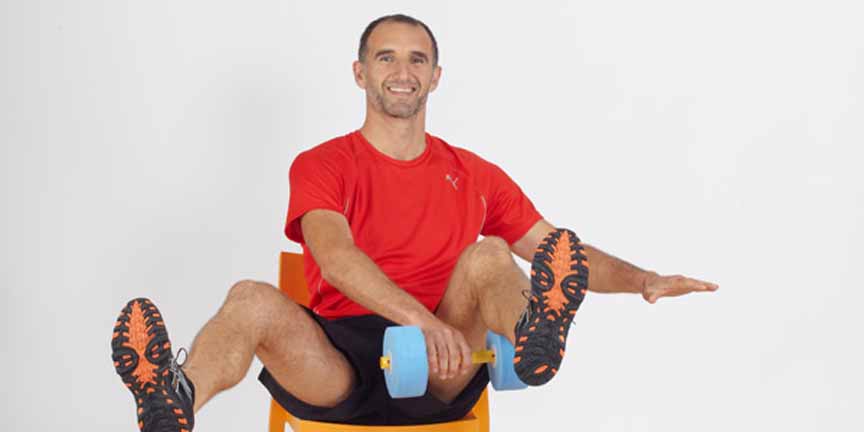Author – Dominic Gili. – ePublication of Australian Fitness Network – Resources Library.

By taking your dumbbells and noodles from shallow to deep and introducing elements of imbalance to your workout, you can challenge participants’ bodies and minds. Dominic Gili shows you how.
Many aquatic fitness instructors have the luxury of teaching in pools with varying depths, and of using dumbbells, noodles and even kickboards in their classes. Yet many do not dare to be different or venture to the deep end for fear of protests from participants.
As instructors it is important that we challenge participants and highlight the benefits of asymmetrical routines and/or deepwater workouts – a major one of these being the excessive recruitment of core muscles, which improves both balance and stability.
As your clients become familiar with asymmetrical (one-sided) workouts, they will become aware of muscle imbalances and will be able to work on building core strength to improve symmetry and balance. And, naturally, the uniquely safe and supportive qualities of water make it the ideal environment in which to test these imbalances.
By including equipment in the mix you will add another dimension to your classes. With dumbbells and noodles, you can build endlessly creative routines that make full use of the pool space available.
Deep water provides a unique and challenging exercise environment, testing participants in many ways:
- Without the floor to stabilise them, participants are forced to focus on building core strength
- The suspended environment encourages a full range of motion, therefore increasing flexibility
- The presence of buoyancy increases resistance to build overall strength.
Deep water creates more postural and alignment challenges than the shallow pool, and instructors need to keep these in mind when programming classes. By incorporating buoyancy belts or flotation equipment into classes, you can enable participants to enjoy their training by focusing on movements rather than merely on keeping their head above water.
The following exercises demonstrate the versatility of water workouts and their adaptability to both shallow and deep-water classes.
START FAMILIAR
Start with a familiar move, such as the Double Push Donkey Kick (photos 1 & 2). This works extremely well in shallow water without equipment as a high energy, high intensity power move. Add dumbbells or a noodle for extra arm, core and leg work. This move can be travelled, taken from side-to-side, rebounded, suspended or kept low (with shoulders under water), all of which will change the intensity and the focus.
INTRODUCE THE ONE-SIDED APPROACH
Now your participants are warmed up, introduce some asymmetrical work to your class. Once your participants work one arm only – with any piece of equipment – they will initially feel imbalanced. Good – now they’ll find out what hard work really is!
The Donkey Kick exercise using only one dumbbell (photos 3 & 4) shifts the focus directly to the core. Participants should work the other arm as normal, creating an imbalance that may make the hips move side-to-side. To counter this hip movement, participants need to control the position of the torso which will help build abdominal and core strength. Core stabilisers are put to the test here so prepare to hear the moans and groans from your class!
When worked one-sided and with equipment, simple moves such as Single Leg Kicks, Cross Country and Rock and Roll, create such an unstable working environment that aggressive recruitment of the stabilising muscles is necessary for alignment and positioning.
TAKE THE ASYMMETRICAL SUSPENDED CHALLENGE
For experienced participants that love a challenge, take an asymmetrical move and suspend it. The Rollercoaster (photos 5 & 6) is a great example of this, with the body constantly feeling off–balance as a single dumbbell is weaved through the open legs in a figure-8 motion. The abdominals are worked extremely hard with this exercise as participants are required to slowly push one shoulder to the opposite knee upon handover of the dumbbell. By cueing a change of direction you will ensure a thorough abs and obliques workout.
TAKE IT DEEP
Now for the real challenge – adding asymmetrical work in the deep. Naturally, with all the other stabilisation factors to consider, the difficulty intensifies considerably in this environment. The Star Cross provides a good example of an exercise which can be effectively adapted to be asymmetrical in the deep water. With or without dumbbells this move (photos 7 & 8) requires participants to maintain a vertical position, with one hand pushing down in front of the hips to meet the opposite foot. You can alternate the arms and legs – fast or slow – or repeat on one side. Now imagine adding only one dumbbell. The aim here is for the initial loss of balance to encourage greater core muscle recruitment.
TAKE A STANCE!
Using a noodle under one foot in the deep (photos 9 & 10) will bring about those groans again – but for all the right reasons! Participants’ legs, core, arms and, as you will see by the focused looks on their faces, minds will be working overtime as they navigate the deep pool using the one leg option.
Experiment here, straight leg up/down, out to the side/back, single leg cycle, leg curl in front or behind – you may even choose to give them a breather with an intermittent double leg tuck.
Have fun with asymmetrical work and remember to try all routines yourself before introducing them to your class. Some routines – particularly the deep water asymmetrical ones – are very difficult and intense, so be sure to allow for adequate recovery time between exercises.
